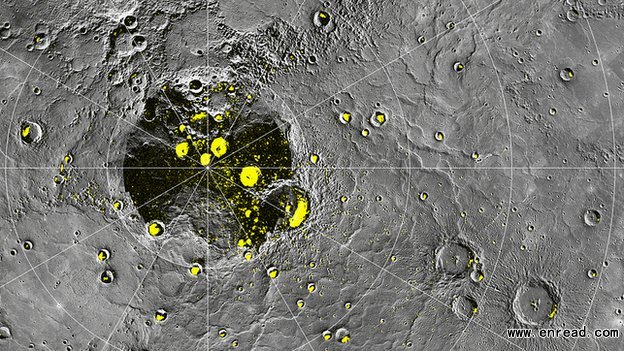|
  
- UID
- 86155
- 帖子
- 60350
- 积分
- 64892
- 学分
- 591606 个
- 金币
- 810 个
- 性别
- 男
- 在线时间
- 2779 小时

|
|
A Nasa spacecraft has found further tantalising evidence for the existence of water ice at Mercury's poles.
美国宇航局的一艘航天飞船发现足够的证据证明水星极地存在水冰。
The radar-bright patches line up perfectly with areas of permanent shadow
Though surface temperatures can soar above 400C, some craters at Mercury's poles are permanently in shadow, turning them into so-called cold traps.
Previous work has revealed patches near Mercury's poles that strongly reflect radar - a characteristic of ice.
Now, the Messenger probe has shown that these "radar-bright" patches line up precisely with the shadowed craters.
Messenger is only the second spacecraft - after Mariner 10 in the 1970s - to have visited the innermost(最里面的) planet. Until Messenger arrived, large swathes of Mercury's surface had never been mapped.
The bright patches were detected by ground-based radio telescopes in the 1990s, but as co-author Dr Nancy Chabot explained, "we've never had the imagery available before to see the surface where these radar-bright features are located."
The researchers superimposed observations of radar bright patches by the Arecibo Observatory on the latest photos of Mercury's poles taken by the MDIS imaging instrument aboard Messenger.
"MDIS images show that all the radar-bright features near Mercury's south pole are located in areas of permanent shadow," said Dr Chabot, from Johns Hopkins University Applied Physics Laboratory (JHUAPL).
"Near Mercury's north pole such deposits are also seen only in shadowed regions, results consistent with the water-ice hypothesis."
However, she cautions, this does not constitute proof, and for many craters, icy deposits would need to be covered by a thin layer (10-20cm) of insulating(绝缘的) debris in order to remain stable.
Maria Zuber, from the Massachusetts Institute of Technology (MIT), who is a co-investigator on the Messenger mission, told BBC News: "The most interesting interpretation of [the radar observations] is that they were due to water ice.
"Sulphur had been proposed, there had also been some suggestion it was roughness - though there was no reason craters at the poles should be rougher than those at low latitudes."
"The new data from Messenger... is strengthening the evidence that there is some sort of volatile there, and water-ice seems quite likely."
She said information from several instruments on Messenger was currently being analysed in order to answer the ice conundrum: "I think this is a question that we can come to a definitive answer on, as opposed to 'we think it may be this'," the MIT researcher explained.
更多英语新闻 |
|